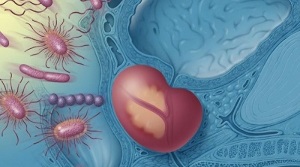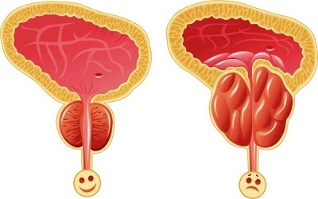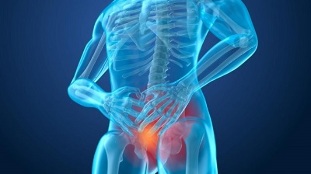
Describes causes, symptoms, diagnostic and treatment features of acute or chronic bacterial prostatitis. The recommendations of urologists will help you quickly identify the disease and promptly contact the clinic to be diagnosed and prescribed a complex therapy.
Prostatitis is one of the most common urinary conditions in men, prostatitis is uncomfortable for life and can lead to genital depression.
According to various estimates, from a quarter to a third of the male population after 40 years of age have prostate problems, in younger people the statistics are better, but still not satisfied. heart.
Today we are going to talk about bacterial prostatitis (BP), looking at its causes, its symptoms and its diagnostic and therapeutic features.
Cause of what happened
The complication of PD is that it often evolves in a sophisticated and undetected form over a long period of time, which delays treatment initiation.
The main cause of bacterial prostatitis is infection of the gland, but not only this leads to disease.
Among the causes of bacterial prostatitis we note:
- Sedentary lifestyle.
- Violation of the rhythm of the sex life.
- Overweight.
- Chronic constipation.
- Alcohol abuse.
To understand how these causes affect the onset and development of pathologies, let's look at their specifics.
Bacteria and infections frequently enter the prostate gland, but this doesn't always lead to a bacterial infection, as the immune system is working.
In addition, good blood flow will quickly take away infections and stimulate local immunity in the area of the gland, helping to prevent infection.
Interesting!With a sedentary lifestyle and irregular sex, the prostate becomes congested, which is an additional factor for the onset of the disease.
If you have a sedentary job, then after 40 and even earlier you should go to the gym or do hip exercises at home.
In addition, obesity and chronic constipation also interfere with blood flow in the glandular region. Keep track of your body weight and include fiber rich foods in your diet to prevent constipation.
As for alcohol, it weakens the immune system (if abused regularly), removes the body's protective barrier and bacteria can more easily "have a place" in the prostate gland.
Remember, bacterial prostatitis does not arise from the beginning, it usually occurs in people who do not follow the health.
Symptoms of the disease
Like any other disease, PD has its own symptoms, the severity of which varies with the stage of the disease and the characteristics of the patient's body.
People with prostatitis often worry about:
- Urinate often.
- Painful feeling when going to the toilet.
- Heavy in groin area.
- Decreased libido, erection problems.
The most obvious symptoms when acute PD develops, if treatment is not started, the disease will become chronic and the severity of symptoms will gradually decrease.
There is no need to get excited here, as chronic inflammation is more difficult to treat and therapy requires more time.
Important!If you have the first symptoms of prostatitis, then this is reason to see your urologist and be diagnosed, as rapid treatment increases your chances of success.
The bacteria that cause prostatitis are microplasma, chlamydia and other bacteria that can enter the prostate gland through urine or through the bloodstream from the main infected organ.
Acute prostatitis
In acute form, the patient may even experience an increase in temperature of up to 40 degrees, as well as develop a fever. Pain in the groin can be painful, discharge of pus from the urethra and frequent urge to go to the toilet.

Acute bacterial prostatitis in men can not be ignored, this is its advantage, since the patient immediately goes to see a urologist.
In an acute form, has a strong burning sensation when going to the toilet and is often irritable, tired.
Without starting treatment in time, PD can lead to complications:
- Abscess in the body of the prostate gland.
- Vasculitis.
- Colloiditis.
- Skin changes in the prostate gland.
In contrast, an abscess can lead to rupture of the prostate gland and severe body intoxication, and when a seminal vesitis occurs, pus appears in the semen and male reproductive function may be terminated. .
Tear gland inflammation is equally dangerous, in which the pain syndrome is intense during sex, which can lead to psychological trauma and impotence.
Pigmentation changes lead to infertility as it reduces sperm motility and sperm quality. In addition, scarred urethral stenosis that makes it difficult to urinate and leads to a bladder obstruction may be the cause of surgical intervention.
Chronic form
Chronic bacterial prostatitis is primary or secondary. In the first case, it develops immediately without an acute phase, in the second case it arises as an advanced form of acute prostatitis.
Symptoms of the chronic stage are fuzzy but also annoying:
- Difficulty urinating.
- There is a growing need to go to the toilet.
- Impaired erectile function.
- A feeling of heat and weight in the perineum.
These are the main signs of chronic PD, if treatment is not started promptly (complex therapy) complications can occur in the form:
- Cystitis.
- Sepsis.
- Pyelonephritis.
- Decreased immunity.
The danger of the disease is less pronounced symptoms that are sometimes overlooked by men.
If it is not possible to not notice the acute phase, then the chronic inflammatory process is often overlooked and thereafter prolonged and not always effective.
Diagnosis of inflammation

When the first signs of prostatitis appear, you need to see a doctor, a doctor will prescribe some diagnostic measures. They will help to determine the presence of inflammation and its type, which will help in effective treatment of the disease.
The complete diagnosis includes:
- Digital examination of the prostate gland.
- Prostate analysis.
- STD smear.
- Ultrasound.
The doctor may also order semen analysis and biopsy to rule out or confirm the presence of cancer in the prostate gland.
Digital examination of the gland is an unpleasant, but important stage in diagnosis, because of the simplicity of the patient, the density is uneven and the size is enlarged.
An exudate analysis will identify the infectious or non-infectious form of the disease and an ultrasound will help the doctor see the contours of the glands - if they are blurred, then this is a clear confirmationof inflammatory prostate disease.
After making the diagnosis, the urologist decides to treat the patient, taking into account:
- Type of prostatitis.
- Disease form.
- Age of the patient.
- Personal characteristics of the patient.
- Presence of concomitant diseases.
Accurate diagnosis allows you to choose the optimal treatment regimen and therapies that show maximum effectiveness. The more stages of diagnosis, the more accurate the diagnosis and the easier it is to prescribe a complex therapy.
Treatment of prostatitis
The therapy for acute and chronic bacterial prostatitis is different, as it requires different dosage of the drug and different duration of treatment.
Interesting!In the early stages it is important to eliminate unpleasant symptoms for the patient to improve quality of life, after which it is the doctor's duty to completely cure the disease, regardless of thewhat kind.
Acute prostatitis therapy

In the treatment of acute prostatitis, therapy for prostatitis is necessarily prescribed; in the case of a bacterial disease, one cannot take without taking antibiotics and antimicrobial drugs.
In addition, the following are specified:
- Pain reliever.
- Immunostimulating drugs.
- Vitamins with trace elements.
- Massage.
PD is selected individually, depending on the primary infection status and the course of the disease.
Important!Antibiotics and antibacterial agents fight germs, while vitamins and immunostimulants help boost immunity.
Massaging in the pre-acute phase speeds up the excretion of the prostate gland and normalizes blood flow in the gland.
In the case of an acute illness, massage and physiotherapy procedures, such as laser and electrophoresis, cannot be prescribed, are not recommended during this period.
This is a mandatory phase of treatment, but not recommended during the acute phase of PD.
Chronic prostatitis therapy
Treating chronic bacterial prostatitis requires longer therapy and more procedures. Often the dosage of the drug is increased.
Added the above treatment stages:
- Use herbs.
- A wide range of physical therapies.
- Do special exercises.
- Consult with a psychologist.
With decreased potency, an increase in the dose of vitamins and stimulants may be prescribed, as the treatment requires frequent sexual activity.
As for exercises, they are chosen depending on the age, the course of the disease and the individual characteristics of the organism. In addition, the doctor also takes into account the presence of side diseases.
Through the article, you already know how to identify bacterial prostatitis, then you just need to carefully monitor your health and consult your doctor when the first signs areof the disease appears.
The sooner the treatment is started, the shorter the treatment will be and the sooner the man will return to a full life.
























